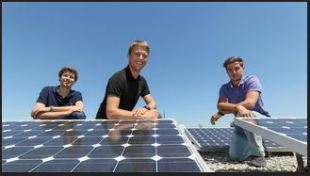Sep 1 2015
Summer series on student projects: Three future micro-engineers have developed an interactive website – a sort of social network about energy – in order to link grid operators with users and encourage users to reduce their electricity consumption and share their ideas.
 Johann Bigler, Alexandre Ringwald and Jean-Charles Fosse © 2015 Alain Herzog
Johann Bigler, Alexandre Ringwald and Jean-Charles Fosse © 2015 Alain Herzog
“We wanted to put people back at the center of the power grid,” said the three students who created the website ThinkEE. Their site, only accessible on the campus at the moment, is becoming a virtual forum for discussions on energy management. It has three objectives: to help consumers become aware of their energy consumption and allow them to share their experience, and to connect suppliers with consumers.
Taking their cue from Switzerland’s goal of reducing electricity consumption by 35% between now and 2035 while at the same time limiting the impact of electricity generation on the environment, Jean-Charles Fosse, Johann Bigler and Alexandre Ringwald, long-time friends, wondered how consumers could be made to change their habits. “We spent a lot of time on this one question,” said Johann. “Preliminary work demonstrated that if people are aware of how much energy they consume, this alone will encourage them to find ways to cut back.” A sort of personal challenge.
And the website suggests a number of ways to encourage the right mind-set. ThinkEE users can, for example, compare their electricity consumption with that of their neighbors, in addition to interacting and exchanging ideas with them and other users. Something like Facebook focused on electricity consumption.
‘Experience points’ are awarded not for reducing watts consumed but rather for the useful tips that users share with others. And users can create groups, to ensure the confidentiality of their data. Only general feedback from multiple users is made public.
Motivated by comfort
Comfort can also be a source of motivation. Or rather discomfort, such as: an overheated classroom, hallway lights that are always on, and a building that’s cold in winter. “Let's look at EPFL: if a lot of students feel it’s too hot in an auditorium and mention it on our website, the facility management can reduce the temperature, which will at the same time reduce electricity consumption,” said Jean-Charles. Connecting users of the electrical grid will encourage them to propose changes to energy suppliers, to property managers in the case of rental apartments, and to facilities managers in office buildings.
In an environment where outlets and devices are equipped with sensors, as is the case in some EPFL buildings, users can see how much energy their devices use in real time. So they can simply have a look at the sensor, modify their behavior and share their observations on the new energy social network. Until this sensor technology makes its way into their homes, people can manually enter the various types of consumption.
New developments in 2016?
The three students, who are now in their internship semester, are thinking about what’s next for their website. Maybe they’ll turn it into a start-up when they come back in 2016.
For Alexandre, this project gave them a taste of engineering in the real world. “Taking the initiative, meeting deadlines and working as a team will be fundamental aspects of our future profession. And the methods we had to learn to create the website will be put to good use in future projects.”